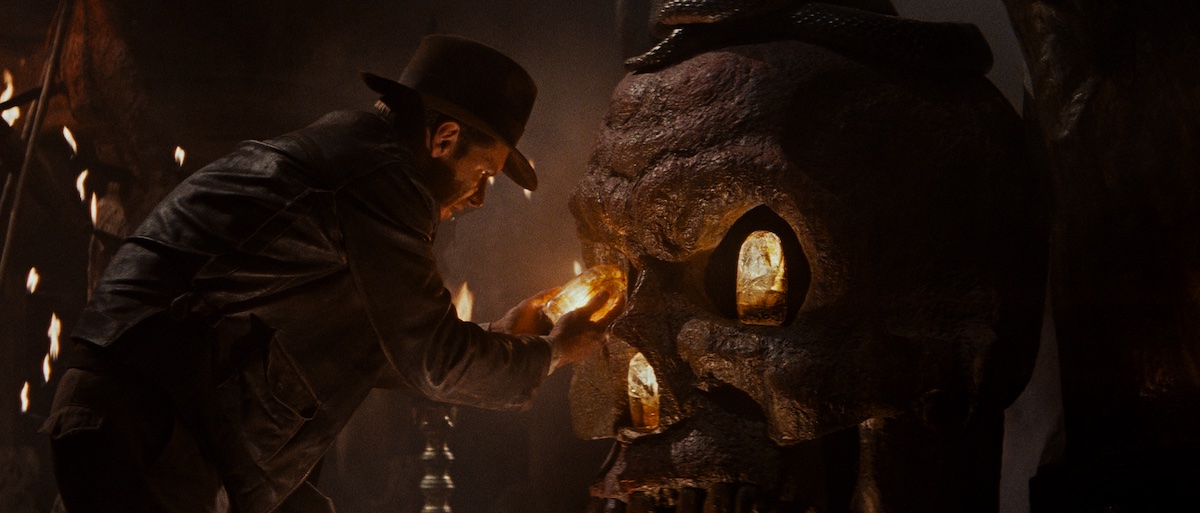Forgive me. With Indy 5 coming towards us, I had no choice but to look at my own writing archives, and resurrect this rave from 2003. Twenty years ago! Little has changed, save (I hope) my skill.
“Om Namah Shivayah!”
Why despair? Why worry? When in doubt, make it a virtue — the Indiana Jones films are nothing alike. No one is in any way like the other, at least tonally. And the least like the others of all is Indiana Jones and the Temple of Doom, and why call that a bad thing? Call it refreshing, because 20 years on, it really is. Temple is Raiders‘ badass kid brother, and like a thousand other poor-tempered middle children, it’s fascinating by default.
There’s some terrible dialogue in Temple, and where Raiders was restrained, Temple is manic. Otherwise, I am loathe to find a single thing wrong with it. It’s a great story, full of darkness and heroism and magic, and it’s certainly one of the most original sequel concepts in the long sad history of franchise filmmaking.
And lest we hedge our bets, Temple is gloriously entertaining. Entertaining in a completely (and somewhat unsettlingly) different way than Raiders, certainly, but entertaining nonetheless. It’s a haunted house ride, where Raiders was a treasure hunt. Rather than globetrotting through the finer spectacles of the 1930s world, it’s a self-contained story dealing with one very nasty place and the nasty deeds that go on there. But, surprisingly, it’s also got the most heart of the Indy trilogy, because at the end of the day, Indy isn’t questing for artefacts or prizes — or even the “fortune and glory” he alludes to in the film — but rather for the souls of about a thousand small children, and the rejuvenation of a dying people.
It’s a bit goofy in presentation, though, somewhat closer to Goonies than Raiders with its candy-coloured lighting, over-the-top set pieces and unrelenting melodrama. Again, I consider this a virtue — Temple is as different from Raiders as its possible to get, while still fitting within the Indy parameters.
There’s no Sallah, no Marcus… but there’s Shorty, who I enjoy immensely, and Willie, who I’m fond of almost to the same degree as Marion… but, of course, for radically different reasons. (Maybe it’s because, when I was 8, my trans diva-in-training best friend did such an outstanding physical impersonation of Willie’s musical-number shimmy, was fond of red dresses, and looked enough like her to be Kate Capshaw’s illegitimate son, that I cannot help but smile when I see her.) Willie, Indy and Shorty form a solid triumvirate for storytelling, a funky dysfunctional family on the Club Med trip from hell. Or to hell — has there ever been a greater cinematic demon than Captain Freaky Deaky his own self, Mola Ram? Mola (may I call you Mola?), you are the stuff of nightmares. You make Toht look like a positive role model for children. You’ve got the crazy eyes, the crazy head, and when all the other crazy has worn off, you rip people’s hearts out of their chests.
Temple of Doom plays, structurally, like a chamber of horrors. Where Raiders interspersed its big action set pieces at approximate ten minute intervals, Temple gives us the collywobbles every eight. From a bleeding sacrificial altar to a gourmet spread of wriggling eels and monkey brains, from a ghoulish sacrifice to a blood-drinking torture scene, there’s no end to the chills. How much “scary” and “gross” can you stand? Temple is an episode of Fear Factor, twenty years before its time.
King among them — probably one of my favourite scenes anywhere — is “the bug scene.” Unlike “the snake scene” or “the rat scene,” Bug-o-rama is an ingeniously conceived set piece that relies on more than just the ick factor to generate its thrills. There’s a ticking clock, a pair of our heroes in bone-crunching jeopardy, and one of John Williams’ all-time great bits of scoring, all propelling those four minutes into being one of the most exciting slices of cinema of all time.
Williams lends great boosts to the parade of the slave children, and the crazed race through the mine car tunnels, making Temple one of his most entertaining and inventive scores. He also concocts a lovely theme for Shorty, which he trots out with equal fanfare to Indy’s theme when it’s Shorty who’s doing all the heroics.
I suppose the principal structural flaw of the Indy trilogy as a whole is that in each film, Indy apparently has to learn the same lesson again. At the end of each quest, he must discard his cynicism and Believe — believe in the Sankara Stones, the Ark, the Grail, God. One would think that one — or maybe two — lessons would do the trick, but apparently not. No matter; as Temple is the chronologically-earliest of the series, his relationship to the Stones — and to the holy men, from the Village Elder to Mola Ram — can be forgiven logically.
Temple is a slicker piece of entertainment than its predecessor, putting the Spielberg mojo in full overdrive to maximum effect. As such, it’s a different animal ideologically from Raiders, but try not to be disappointed… it’s still a hell of a good time.
